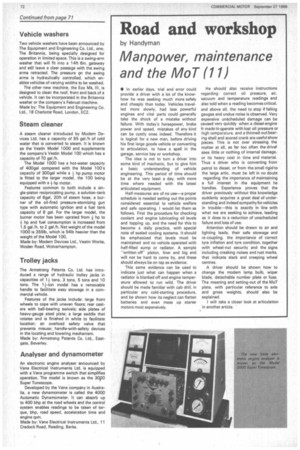Road and workshop
Page 74

If you've noticed an error in this article please click here to report it so we can fix it.
by Handyman
Manpower, maintenance
and the MoT (1 1 )
• In earlier days, trial and error could provide a driver with a lot of the knowhow he was seeking much more safely and cheaply than today. Vehicles travelled more slowly, had less powerful engines and vital parts could generally take the shock of a mistake without failure. With today's horsepower, brake power and speed, mistakes of any kind can be costly ones indeed. Therefore it is logical for a new man, before driving his first large goods vehicle or converting to articulation, to have a spell in the garage, service bay or workshop.
The idea is not to turn a driver into some kind of mechanic, but to give him a basic understanding of vehicle engineering. This period of time should be at the very least a day, with more time where needed with the latest articulated equipment.
Half-measures are of no use—a proper schedule is needed setting out the points considered essential to vehicle welfare and safe operating. I would list them as follows. First the procedure for checking coolant and engine lubricating oil levels and topping up, and the need for this to become a daily practice, with special note of sealed cooling systems, It should be emphasized that levels must be maintained and no vehicle operated with half-filled sump or radiator. A sample "written-off" piston, liner and big end will not be hard to come by, and these should always be on tap as evidence_ This same evidence can be used to indicate just what can happen when a radiator is blanked off and engine temperature allowed to run wild. The driver should be made familiar with cab drill, in particular any cold-starting procedure, and be shown how its neglect can flatten batteries and even mess up starter motors most expensively.
He should also receive instructions regarding correct oil pressure, air, vacuum and temperature readings and also told when a reading becomes critical, and above all, the need to stop if falling gauges and undue noise is observed. Very expensive unscheduled damage can be caused very quickly when a diesel engine is made to operate with lost oil pressure or high temperature. and a thinned-out bearing shell and scored crank are useful show pieces. This is not over stressing the matter at all, as far too often the drivet sees little or nothing of internal damage. or its heavy cost in time and material. Thus a driver who is converting from petrol to diesel, or from the small rigid to the large artic, must be left in no doubt regarding the importance of maintaining a full interest in the equipment he handles, Experience proves that the driver previously without this knowledge suddenly acquires a great deal of understanding and indeed sympathyfor vehicles in trouble--this is exactly in line with what we are seeking to achieve, leading as it does to a reduction of unscheduled failure and loss of use.
Attention should be drawn to air and lighting leads, their safe stowage and re-coupling, the importance of correct tyre inflation and tyre condition, together with wheel-nut security and the signs including creaking noises and rust marks, that indicate slack and creeping wheel centres.
A driver should be shown how to change the modern lamp bulb, wiper blade, detachable number plate or fuse. The meaning and setting-out of the MoT plate, with particular reference to axle and gross weights, should also be explained I will take a closer look at articulation in another article.
































































































































































































